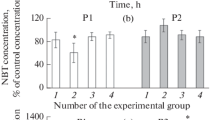Abstract
Interactions of Aeromonas caviae, Aeromonas veronii biotype sobria, and Aeromonas hydrophila strains isolated from fecal specimens of humans with gastroenteritis on murine macrophages, J774 cells, were investigated. Analyses of cellular morphology and DNA fragmentation in phagocytes infected with these strains exhibited typical characteristic features of cells undergoing apoptosis. We observed the morphological changes, including condensation of nuclear chromatin, formation of apoptotic bodies and blebbing of cell membrane, and fragmentation of nuclear DNA into oligonucleosomal fragments. The lowest apoptotic index did not exceed 25%, whereas the highest reached 78% at 24 h and 96% at 48 h after infection. After incubation of J774 cells with cytotoxic enterotoxin isolated from A. veronii biotype sobria strain, we noted that the toxin was able to trigger cytotoxicity and apoptosis of macrophages. The results indicate that apoptosis could be one of the mechanisms contributing to the development of Aeromonas-associated diarrheal disease.

Similar content being viewed by others
References
Chopra AK, Houston CW (1999) Enterotoxins in Aeromonas-associated gastroenteritis. Microbes Infect 1:1129–1137
Chopra AK, Xu X-J, Ribardo D et al (2000) The cytotoxic enterotoxin of Aeromonas hydrophila induces proinflammatory cytokine production and activates arachidonic acid metabolism in macrophages. Infect Immun 68:2808–2818
Desphande MS, Ambagala TC, Ambagala APN et al (2002) Bovine CD 18 is necessary and sufficient to mediate Mannheimie (Pasteurella) haemolytica leukotoxin-induced cytolysis. Infect Immun 70:5058–5064
Dockrell DH (2001) Apoptotic cell death in the pathogenesis of infectious diseases. J Infect 42:227–234
Falcon RM, Carvalho HF, Joazeiro PP et al (2001) Induction of apoptosis in HT29 human intestinal epithelial cells by the cytotoxic enterotoxin of Aeromonas hydrophila. Biochem Cell Biol 79:525–531
Figueras MJ (2005) Clinical relevance of Aeromonas spp. Rev Clin Microbiol 16:145–153
Figueras MJ, Soler L, Chacon MR et al (2000) Extended method for discrimination of Aeromonas spp. by 16S rDNA RFLP analysis. Int J Syst Evol Microbiol 50:2069–2073
Galindo CL, Sha J, Fadl AA et al (2006) Host immune response to Aeromonas virulence factors. Curr Immunol Rev 2:13–26
Harf-Monteil C, Le Fleche A, Riegel et al (2004) Aeromonas simiae sp. nov., isolated from monkey faeces. Int J Syst Evol Microbiol 54:481–485
Krzymińska S, Kaznowski A, Lindner K et al (2003) Enteropathogenic activity and invasion of Hep-2 cells by Aeromonas caviae isolates. Acta Microbiol Pol 52:277–283
Krzymińska S, Kaznowski A, Spychała H (2006) Purification and characterization of cytolytic toxins produced by Aeromonas hydrophila and Aeromonas veronii biotype sobria strains. Pol J Microbiol 55:37–42
Laohachai KN, Bahadi R, Hardo MB et al (2003) The role of bacterial and non-bacterial toxins in the induction of changes in membrane transport: implications for diarrhea. Toxicon 42:687–707
Miñana-Galbis D, Farfan M, Carme Fuste M et al (2007) Aeromonas bivalvium sp. nov., isolated from bivalve molluscs. Int J Syst Evol Microbiol 57:582–587
Moss JE, Idanpaan-Heikkila I, Zychlinsky A (2000) Induction of apoptosis by microbial pathogen. In: Cossard P, Bouquet P, Normark S, Rappuoli R (eds) Cellular microbiology. American Society for Pharmacology and Biology, Washington, DC
Nagata S (2005) DNA degradation in development and programmed cell death. Annu Rev Immunol 23:853–875
Navarre WW, Zychlinsky A (2000) Pathogen-induced apoptosis of macrophages: a common end for different pathogenic strategies. Cell Microbiol 2:265–273
Ruckdeschel K, Roggenkamp A, Lafont et al (1997) Interaction of Yersinia enterocolitica with macrophages leads to macrophage cell death through apoptosis. Infect Immun 65:4813–4821
Sgonc R, Gruber J (1998) Apoptosis detection: an overview. Exp Gerontol 33:525–533
Shao J, Liu J, Xiang L (2004) Aeromonas hydrophila induces apoptosis in Carrassius auratus lymphocytes in vitro. Aquaculture 229:11–23
Szczuka E, Kaznowski A (2004) Typing of clinical and environmental Aeromonas sp. strains. J Clin Microbiol 42:220–228
von Gravaenitz A (2007) The role of Aeromonas in diarrhea: a review. Infection 35:59–64
Author information
Authors and Affiliations
Corresponding author
Rights and permissions
About this article
Cite this article
Krzymińska, S., Kaznowski, A. & Chodysz, M. Aeromonas Spp. Human Isolates Induce Apoptosis of Murine Macrophages. Curr Microbiol 58, 252–257 (2009). https://doi.org/10.1007/s00284-008-9316-4
Received:
Revised:
Accepted:
Published:
Issue Date:
DOI: https://doi.org/10.1007/s00284-008-9316-4




